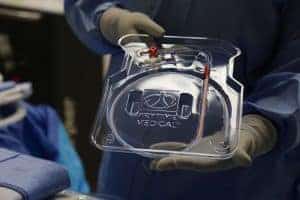View Larger Image

Doctors prepare for cesarean section delivery with REBOA device.
Catheter Device Slows Down Internal Bleeding, Saves Lives
| May 1, 2018 | Angela Hall of Pineville, Missouri, was halfway through her pregnancy when she had a scare that sent her to her doctor in Rogers.
“I experienced some bleeding,” Hall said. “Having had a couple of miscarriages prior to this pregnancy, I was worried it could be happening again.”
Hall says once they determined the baby was okay, doctors did a specialized ultrasound that concluded she had placenta previa. Her placenta, the organ surrounding the baby in utero, was covering her cervix. This condition can cause bleeding during the second and third trimesters of pregnancy.
Hall’s obstetrician suggested she go to UAMS. She was transferred from Rogers to Little Rock at about 22 weeks along.
When she wasn’t in the hospital, Hall remained close. She temporarily moved into Markham House Suites across the street from UAMS.
“I was hospitalized a couple more times for bleeding. We decided to deliver at 34 weeks to get the baby out as safely as possible,” Hall said.
In addition to placenta previa, Hall had another placental abnormality called morbidly adherent placenta. It happens when the placenta grows into the uterus and doesn’t detach as it normally would after the baby is born. With this condition, the placenta can extend into surrounding tissues and other organs.
“With Mrs. Hall, we were able to make the diagnosis based on her ultrasound,” said Adam Sandlin, M.D., a maternal-fetal specialist and an assistant professor in the UAMS Department of Obstetrics and Gynecology. “Our goal is to identify these cases before delivery so that we can be prepared for any potential complications.”
An early diagnosis is ideal, Sandlin says. It helps them prepare for potential bleeding and decide the best way to approach the delivery.
For the first time this year, UAMS began utilizing a device that would hopefully help to prevent or severely decrease the need for blood transfusion at the time of delivery by slowing down blood loss in patients with these types of placental abnormalities.
It’s called REBOA, short for resuscitative endovascular balloon occlusion of the aorta. Cleared by the FDA in 2015, the Reboa device is a catheter with a deflated balloon that is inserted through the groin into the aorta, the main artery of the body, to slow down internal bleeding. If the patient begins to hemorrhage, a surgeon inflates the balloon to block the aorta, preventing the loss of too much blood while maintaining blood flow to vital organs such as the brain, heart and kidneys.
A multidisciplinary team of experts assembles for the procedure, including high-risk obstetricians, neonatologists, a trauma surgeon, and an anesthesia team specially trained for these cases.
J.R. Taylor, M.D., an assistant professor who practices in the UAMS Division of Trauma was trained to do this procedure during his fellowship at the University of Texas Health Science Center at Houston. He described the procedure as cutting edge and said UAMS is one of five places in the country regularly doing the procedure for placental abnormalities.
Taylor says the concept of using balloons on the inside of the artery to stop bleeding was first used in the early 1950s in the Korean War on two combat casualties. He says the technology began to improve in the 1990s with the advent of endovascular surgery, using catheters and wires to fix diseased and ruptured blood vessels.
“A group of forward-thinking trauma and vascular surgeons identified a need to control hemorrhage in combat casualties from Iraq and Afghanistan who were bleeding to death from injuries that couldn’t be controlled with a tourniquet,” Taylor said. “The first papers outlining the technique came out in 2011. Since then the technology has improved so much that we are now able to close up the aorta with simple access thru the skin in patients bleeding to death.”
Hall never bled enough to require inflation of the balloon in her operation. Taylor says that is a win for both the patient and the team.
“In these situations, it’s better to have and not need than to need and not have,” he said.
Baby Alice was born Feb. 13 via cesarean section at 34 weeks and 5 days. She was in the NICU more than three weeks before she and her mother returned home to her five siblings and father.
“I’m grateful for Dr. Sandlin and Dr. Taylor. I knew beforehand I would be treated by the best. I’m glad I got to be here and survive.”



